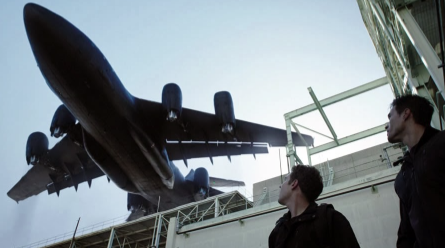In a question about whether tail surfaces add to lift, I thought of a fictional example where the tail surface very much adds to lift: The Agents of S.H.I.E.L.D C-17, highly modified and super-engined. Presumably the T-tail vertical stabilizer (still present) provides downforce for trim, and the aft wing provides lift; though that wouldn't necessarily have to be so.
And my first reaction was "The center of gravity on this would be totally unworkable." But is that really true?
I mean, it looks like the rear wing would account for about 20% of lift, maybe a tick more because it is being blown by the forward engines. So if you marked the main-wing center of lift and the aft-wing center of lift, the aircraft CG would need to be inside that range, about 20% aft of main-wing.
Would that put the CG aft of the rearmost landing gear wheel? Wouldn't it "pop a wheelie" the moment they lost elevator authority?
But then, if their Stark/Asgard/Tesseract tech can get 150,000 lbf out of a PW2000, maybe they can move the landing gear aft.
If you haven't seen Agents of Shield, spoiler alert...
One hat-trick that aircraft can do is "tip the engines up" and go into full VTOL.
The cattywumpus angle of some of the engines are dynamic adjustments for station keeping; this is obvious in the video.
That seems to place some very particular demands on Center of Gravity, noting that the engine lift is significantly forward of wing lift. Especially when you fail an engine - worst case being a tail engine. Presumably, everything is specced so a single engine rollback in VTOL/hover mode could be easily compensated for. Clearly, that would factor into CG also, as the loss of a tail engine would be the worst case, necessitating the CG stay fairly forward.
Would the CG for forward flight be compatible with the CG for vertical hover?


